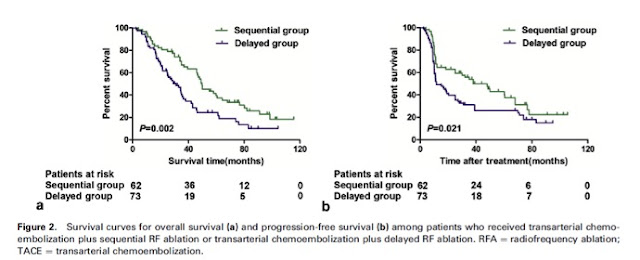Impact of Eliminating Postprocedural Antibiotic Prophylaxis in Patients without Biliary Instrumentation or Bypass Undergoing Hepatic Artery Embolization for Hepatic Malignancies
To assess the infection rate after eliminating postprocedural antibiotics in patients undergoing hepatic artery embolization (HAE) for primary and secondary hepatic malignancies.
Take away point
Eliminating postprocedural antibiotics in patients undergoing HAE did not lead to an increase in infectious complications.
Reference
Impact of Eliminating Postprocedural Antibiotic Prophylaxis in Patients without Biliary Instrumentation or Bypass Undergoing Hepatic Artery Embolization for Hepatic Malignancies. Seo, Susan K. et al. Journal of Vascular and Interventional Radiology, Volume 30, Issue 12, 1895 - 1900
Click here for abstract
Study design
Retrospective cohort study of hepatic artery embolization patients who received either pre and postprocedural antibiotics or only preprocedural antibiotics.Funding Source
Partially funded through the US National Institutes of Health/National Cancer Center
Setting
Memorial Sloan Kettering Cancer Center, New York
Table 2. Comparison of outcomes for Adult Patients without Prior Biliary Instrumentation or Bypass undergoing HAE.
Summary
The authors performed a retrospective cohort study to compare infectious complications in hepatic artery embolization (HAE) patients that either received either pre- and post-procedure antibiotic prophylaxis or only pre-procedure antibiotic prophylaxis. Only patients without a history of prior biliary instrumentation or bypass were included. Patients that also received ablation or selective internal radiation treatment (SIRT) were included.
Group A comprised of 150 patients who underwent 204 HAE procedures and received pre- and post-procedure antibiotic prophylaxis. Group B comprised of 171 patients who underwent 204 HAE procedures and received only pre-procedure antibiotic prophylaxis. The retrospective cohorts were chosen based on consecutive cases performed a year before and a year after the guidelines at the author’s institution were changed to no longer recommend post-procedure antibiotic prophylaxis.
The pre-procedure antibiotic prophylaxis regimen was 1g of cefazolin iv pre-procedure. Patients with a severe penicillin allergy received clindamycin (900 mg iv for 1 dose pre-procedure) and gentamicin (1 dose 1.5 mg/kg iv pre-procedure). In the group receiving post-procedure prophylaxis, the regimen was either 1g cefazolin every 8 hours post-procedure for 3 doses or clindamycin (900 mg iv q8H for 3 doses) plus gentamycin (1.5 mg/kg q8H post-procedure for 3 doses).
The primary outcome was any infection requiring antimicrobial treatment within 30 days of hepatic artery embolization. In the comparison of HAE patients with or without ablation or SIRT, with a competent sphincter of Oddi, receiving both pre- and post-procedure antibiotic prophylaxis and only pre-procedure antibiotic prophylaxis: No significant difference was identified in 30-day infection rates. No significant difference was identified in the average time to postprocedural imaging or in the proportion of patients with liver imaging within 14 days of the procedure. No significant difference was found in unplanned readmissions within 30 days or in 30-day all-cause mortality. Elimination of post-procedure antibiotics also led to better guideline adherence within the author’s institution.
Commentary
The authors evaluated 321 patients who underwent 425 hepatic artery embolization procedures and received either pre- and post-procedure antibiotic prophylaxis or only pre-procedure antibiotic prophylaxis. No significant difference was seen in infectious complications or any of the other endpoints between the two groups. While this study is limited by its retrospective design and exclusion of patients with prior biliary intervention, these findings further confirm that a single pre-procedure prophylactic dose of either cefazolin or clindamycin plus gentamycin provides adequate antimicrobial coverage for these patients undergoing HAE and supports the 2018 SIR recommendations, and suggest the post-procedure antibiotic prophylaxis may be unnecessary.
Post author
Maxwell R. Cretcher, DO
Resident Physician, Integrated Interventional Radiology
Dotter Department of Interventional Radiology
Oregon Health & Science University




